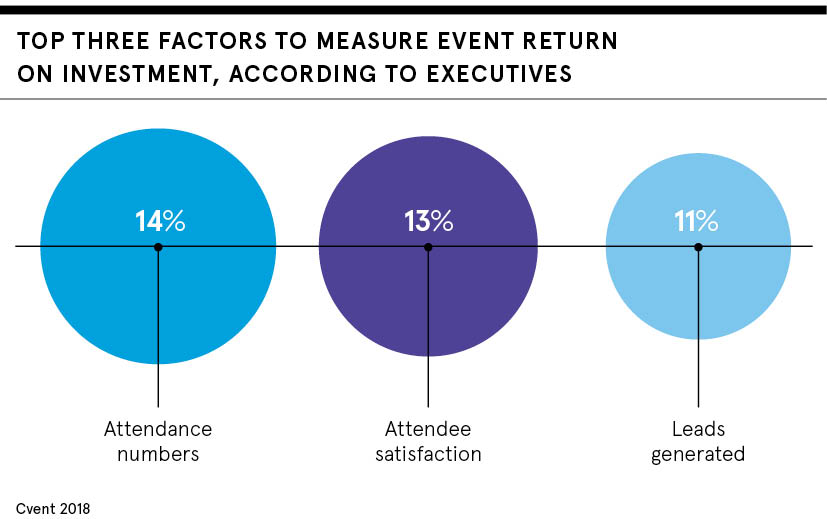Once upon a time, if an event ran smoothly and attracted enough attendees, it was considered a success. But with more marketing budget now being allocated, businesses need a better understanding of the return on investment delivered post-event.
According to Damian Ferrar, innovation director at global experience agency Jack Morton Worldwide, his clients increasingly want event investment justified in the same way as digital spending.
“As event and experience budgets increase, there is definitely pressure to increase value,” he says. “Historically events and experiences have been quite practical and they haven’t necessarily been tied to a brand strategy, but they are becoming more sophisticated now.”
Why you must choose what to measure pre-event
According to the IPA Bellwether Report, event budgets across the UK grew 3.4 per cent during the first quarter of 2019, while in America they are expected to account for at least 20 per cent of total marketing budgets this year, research from Bizzabo shows.
Capitalising on this investment is crucial, but to profit post-event, businesses need to change the way they behave pre-event and this starts with setting measurable objectives. After all, if you don’t know what success looks like, you can’t know if you’ve been successful.
Jack Morton Worldwide is working with clients, including Google, Reebok and Airbnb, to establish baseline measurements for things such as attendance, footfall, dwell time and even emotional response that it can benchmark for future events. Measurement also continues after the event, looking at the content attendees request post-event and how long they spend with it, for example.
“We’re building a platform where we can feed in APIs [application programming interfaces] from different partners that create a comprehensive dashboard of results,” says Mr Ferrar. “Before the event happens, each department needs to be clear on what data is valuable to them because it’s very difficult to analyse a set of data if you don’t know what you’re looking for. Clarity about the success criteria is the most important thing.”
Companies must think about post-event audience actions
Giving businesses the complete picture in terms of the return on investment their events have delivered means sometimes having to find ways to quantify the intangible, such as the impact an event had on attendees. Luke Flett, client relationship director at events and communications agency Spark Thinking, believes defining the behaviour you want attendees to demonstrate post-event is integral to this.
“Things are complex and organic when you are dealing with a group of people’s intellectual and emotional response to what they are experiencing,” he says. “Value begins to appear when the commissioned agency can help the client to define what sort of outcomes are wanted from a session, meeting or series of events. The common phrase asked of clients is ‘what do you want your audience to go away and do?’”
John Fisher, managing director of brand engagement agency FMI, agrees that businesses must think beyond the event itself to really capitalise on it.
“We all know stories of companies who’ve had a big, flash product launch and then because they’ve spent so much money on it, don’t talk to the attendees for another three months,” he says. “The whole point is it’s a comms programme. It starts at the beginning of the process when you invite people to the event, through the event itself, then to the post-event survey and a sales analysis three months down the line.
“Return on investment of events is at least a six-month process, with the event being in the middle. If you don’t do all the things around it, you risk losing out.”

Post-event communications is crucial
Mr Fisher, who works with clients including LG, Sony and Hotpoint, adds that all stakeholders in a business need to co-operate to maximise value from a live event. He says: “You have to talk to the marketing people and the market research people. You need to establish the expectations for the event and then look at whether those expectations were met. If they weren’t, you need to ask, what are we doing about it in terms of post-event comms?”
According to Jack Morton’s Mr Ferrar, input shouldn’t come from within the business alone. He advocates extending the lifespan of an event by getting attendees involved at the very outset.
“One of the things we’re trying to do is get events to last longer. Typically, it’s a finite number of hours or a number of days that your event lasts for, but you can extend the post-event experience by investing more in the pre-event experience,” he says.
“We’re doing that by inviting attendees to participate earlier, asking them what kind of content they’re interested in, what’s the information they need from a particular event? Inviting them to shape the content not only makes the event more relevant for them, it means they’re more likely to engage with content post-event.”
How to encourage participants to share their data
This collaborative approach also makes participants more willing to share personal information, which can be a stumbling block for businesses organising events after the European Union’s General Data Protection Regulation.
“Automation and artificial intelligence are great for gathering data, but there’s a massive lack of trust towards them. The challenge is how do you interact with a person and deal with that free flow of data in a very trusted way? You just need to be really clear about how long you’re going to have that information and what it’s going to be used for. Where possible, you always look at a very short-term requirement for data and use it as a separate data pool to the customer data the client already owns,” says Mr Ferrar.
While this makes it harder in terms of the delivery process, through embracing transparency, businesses can still gather the data they need to extract maximum value from their events.
Why you must choose what to measure pre-event
Companies must think about post-event audience actions

